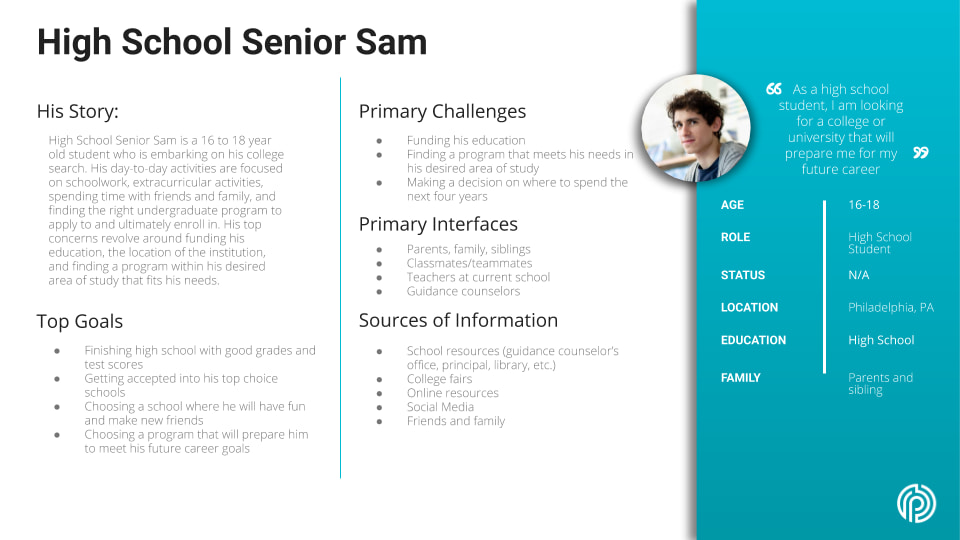Written By:
Tim Stobierski
While you might think of “brand voice” as something that only exists in the corporate world, the truth is that every organization should put in the effort to identify and establish a brand voice—including schools. Here, we explore:
-
What a brand voice is
-
Why it’s important for schools
-
Four key factors that should influence your brand voice
-
How you can use it in your marketing efforts
As a marketer who is at least partially focused on supporting enrollment, you probably spend a lot of time writing. Writing emails, writing flyers, writing website copy, advertisements, poster text—the list goes on. Depending on the size of your marketing team, you may be the only person responsible for all of this language, or you may be just one of multiple people drafting text for various marketing purposes.
In either case, your job is to write marketing material that accurately reflects your school. But if you haven’t developed a strong brand voice for your school, doing so effectively time and time again can be a challenge.
Below we explore the concept of brand voice, explain why creating a consistent and accurate brand voice is so important for your school, and offer a number of tips that you can use when crafting your voice.

What is a brand voice?
Brand voice refers, quite literally, to the voice that a company (or in your case, a school) uses to communicate. Your brand voice will influence everything from the language and words you use to the tone of your communications.
The most successful organizations and institutions will reference their brand voice when drafting both internal and external communication, which includes things like:
- Email copy
- Website copy
- Advertisements
- Print collateral (flyers, handouts, posters)
- Mailers
- Logos
- Visual components
To put it another way: Imagine that the spirit of your school is actually capable of speaking. What would it sound like? What words would it use? Would it seek to inspire? To enlighten? Is it kind and encouraging, or serious and stern? That voice is your school’s brand voice.

Why is brand voice important for your school?
Having a strong, clear, and easily identifiable brand voice is incredibly important for any organization—whether a company or a school—for a number of reasons.
On the one hand, when you have a clear brand voice and guidelines for how employees should use that voice, you are ensuring that all of your various pieces of content are working together to communicate the same basic message, feelings, and theme. You are presenting a cohesive image of your school to prospective families and students. This reduces the risk that different pieces of content might conflict with one another on an emotional level, helping to minimize cognitive dissonance and the confusion that it brings.
Identify and fine tune your school’s brand voice by downloading our free worksheet!

On the other hand, an unique brand voice will help your school stand out from the competition—especially if those competitors do not have a strong brand voice of their own.
And finally, it’s important to understand that families enroll their children in schools that align with their values, beliefs, and the goals that they have for their children. An effective brand voice will empower you to attract mission-appropriate, right-fit families and students to your school through your marketing materials.
4 Things to Consider Before Creating A Brand Voice for Your School
Because your school’s brand voice will impact every piece of marketing and communications material that you create, it’s important that you get it right. That’s why, before you settle on a particular voice, we recommend that you take into consideration the following factors.
1. Your School’s Mission
All schools exist to educate their students. But truly exceptional schools are guided by a mission. This mission is what makes your school unique; it’s what differentiates you from all of the other schools in your area. As such, it should inform your marketing materials and your brand voice.
Before defining your brand voice, understand:
- What is your school’s mission?
- How is this unique from other schools your prospective students and families might be considering?
- What words, phrases, and tone of voice lend themselves to the underlying message of your mission?
2. Your Ideal Student & Family
Once you understand what your school’s mission is and how it differs from your competition, you need to define what an ideal, “mission-appropriate” student or family looks like for your school. This is the person that you will be using your brand voice to market to; it’s crucial that you have a clear picture of who they are and what they value.

While you’re at it, if you haven’t yet done so, now can be an excellent time to create a student persona that formalizes this individual. Download our Student Persona Toolkit to get started for free!
3. Your Enrollment Funnel & The Student Journey
Your enrollment funnel (also called the admissions funnel) refers to the steps that a prospective student takes as they go from an unknown person to a known contact in your database and, ultimately, an admitted and enrolled student. The student journey, on the other hand, refers to the steps that a prospective student takes as they research their educational options, including the everything that happens before they enter your enrollment funnel as well as after they have entered your funnel.
By understanding what the student journey and enrollment funnel look like, you can ensure that you are defining a brand voice for your school that speaks to your prospects where they are in that journey.

Ask yourself: What questions does a prospective student or family have as they consider schools, including your school? What challenges, worries, concerns, or aspirations do they experience along their journey? How can you use your brand voice to address each of those things?
4. Your School’s Founder
When many businesses sit down to define their brand voice, they often turn to their founder for inspiration. After all, who knows the company mission, vision, and customer better than the person (or persons) who started it all?
The same is true for most schools. If your school’s founder is still involved with the school, try to channel their voice as you settle your school’s brand voice. If they are no longer involved, seek out individuals who knew the founder well, and who can offer some direction. In the event that the school was founded many years ago, it may be possible to turn to the school’s archives to get a sense of what the founder was like and how their personality influenced the direction of the school.
For most schools, the founder and original leadership team are likely long gone. In this case, with decades, if not hundreds of years of operation, the school’s voice is likely well understood and known among the current school leaders, teachers, and faculty. Turning to the parents and families of current students for their perspective might make sense as well.
Using These Factors To Create Your Brand Voice
Armed with all of the information and insights discussed above, you can finally sit down and create your school’s brand voice. We recommend that you download a brand voice worksheet (like this one) to help guide you through the exercise.
How should you actually define your brand voice? This will vary depending on the size of your institution, but typically we recommend that you:
- Begin with an initial brainstorm on your own or with a few people who understand your school mission very well.
- Share those initial conclusions with the broader community of stakeholders, including the headmaster/principal/heads of school, members of the board, department managers, etc. Incorporate their feedback into your framework.
- Once you have semi-final messaging, you should survey a number of current students and family, as well as alumni. Your goal is to validate your conclusions and assumptions and ensure that you are channeling a voice that your school community values.
Once it is settled, incorporate your school’s brand voice into your editorial guidelines, and ensure that everyone who creates content of any sort for your school understands these guidelines. This should include website copy, print, brochures, emails, flyers, advertisements—every single component of your content marketing or inbound marketing strategy. Importantly, every year or so you should audit your marketing materials to ensure that everything complies.







